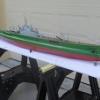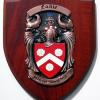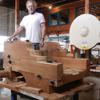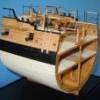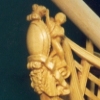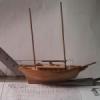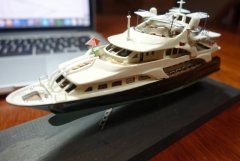-
Posts
993 -
Joined
-
Last visited
Reputation Activity
-
 Wintergreen got a reaction from Piet in Francis Pritt by Jim Lad - FINISHED - Scale 1:48 - Australian Mission Ship
Wintergreen got a reaction from Piet in Francis Pritt by Jim Lad - FINISHED - Scale 1:48 - Australian Mission Ship
Its such a pretty little ship, John.
Hope you are well.
-
 Wintergreen got a reaction from mtaylor in Francis Pritt by Jim Lad - FINISHED - Scale 1:48 - Australian Mission Ship
Wintergreen got a reaction from mtaylor in Francis Pritt by Jim Lad - FINISHED - Scale 1:48 - Australian Mission Ship
Its such a pretty little ship, John.
Hope you are well.
-
 Wintergreen got a reaction from GLakie in Francis Pritt by Jim Lad - FINISHED - Scale 1:48 - Australian Mission Ship
Wintergreen got a reaction from GLakie in Francis Pritt by Jim Lad - FINISHED - Scale 1:48 - Australian Mission Ship
Its such a pretty little ship, John.
Hope you are well.
-
 Wintergreen reacted to michael mott in Herreshoff Buzzards Bay 14 by michael mott - 1:8 scale - SMALL
Wintergreen reacted to michael mott in Herreshoff Buzzards Bay 14 by michael mott - 1:8 scale - SMALL
Thanks for all the fine comments and encouragements.
Build part 34
The cockpit area planks have been trimmed to withing a 1/64 of the cockpit stringer and the longest planks cleaned up a bit.
Now the planks are getting shorter and will go a bit faster.
All of the billets have been curved ready for splitting.
gluing progresses
Something I have been thinking about is to finish gluing all the forward planks including the king plank then do a preparatory sanding. Next using a razor blade like a putty knife and forcing a thickened glue into the remaining space for the caulking. I was wondering if anyone has thickened up the glue with the Costello dust and how it responded.
Michael
-
 Wintergreen reacted to Jim Lad in Francis Pritt by Jim Lad - FINISHED - Scale 1:48 - Australian Mission Ship
Wintergreen reacted to Jim Lad in Francis Pritt by Jim Lad - FINISHED - Scale 1:48 - Australian Mission Ship
It seems forever since I last updated the log. Things have been pretty hectic around here plus both Pam and I have had a few health issues which have slowed things down considerably. Thankfully I'm now able to get back into the workshop.
All the spars have now been made but, as can be seen in the photos below, not yet detailed. The jaws of the mizzen boom and gaff have now been finished off, so the next job on the spars will be to get some bands made, which means I'm really going to have to haul out the soldering gear soon or I'll run out of things to do on the model for lack of metal fittings. I still have the dunny to make plus the windlass is only half done, so maybe I can put off the soldering just a little longer.
PS: I actually enjoy soldering once I get started, but it seems to take me a heck of a long time just to get the equipment organised.
John
-
 Wintergreen reacted to Jim Lad in Francis Pritt by Jim Lad - FINISHED - Scale 1:48 - Australian Mission Ship
Wintergreen reacted to Jim Lad in Francis Pritt by Jim Lad - FINISHED - Scale 1:48 - Australian Mission Ship
A Christmas update. The 'Pritt' continues to move ahead slowly. The pin rails are now fitted (although I now realise I forgot to photograph the model with them fitted - next time). The belaying pins on these vessels were, generally, simple iron or steel bars fixed through the rails - nothing fancy on a pearl sheller! The rudder has now also been fitted and the tiller made, but only temporarily in place for the photographs - it still needs painting and the steering blocks fitted before it's finally permanently fitted. The end of the tiller kicks up like that at the end so that it's about hip height on a man standing to steer, although steering was generally done using the tiller ropes.
You will notice the unusual fittings for securing the rudder. This type of rudder fitting is typical of T.I. pearl shellers - the upper gudgeon is simply a plate that is passed through a slot in the rudder abaft the rudder post and the lower gudgeon is a round fitting into which the lower end of the rudder post fits.
The masts have been commenced - the main mast has been shaped and the mizzen is tapered ready for shaping. The spars are being made from Celery Top Pine, a traditional Tasmanian boat building timber and beautiful to work with. I got a couple of scraps of it from a boatyard when we were visiting Tasmania a couple of years ago.
A happy Christmas to all.
John
-
 Wintergreen got a reaction from Louie da fly in Sea of Galilee boat by Wintergreen - FINISHED
Wintergreen got a reaction from Louie da fly in Sea of Galilee boat by Wintergreen - FINISHED
Another update.
Not that I've been busy as a bee, but things are nevertheless progressing. (it can also be the fact that our pastor asked about it the other day...)
The first strakes I put in, without scarfs. Really tedious and hard to get proper alignment and nice joints to stem and stern. So, to ease my burden I changed the habit and cut the planks in two. The joint is a simple box joint, slightly angled. I will not put a covering piece on the inside, instead there are pins drilled through the topmost plank , into the underlying plank. This is also done at stem and stern.
The aftermost plank goes on first and the pin at the rear helps keeping the plank in place longitudinally. While the furthermost plank gets the pin in place prior to gluing to aid in proper fitting in the box joint.
A really sharp carpenters knife is useful to work away the waste. Apart from that, ordinary files are used and a little no 12 Stanley low angle block plane to work on the plank height (or width, whatever you want to call it).
Also notable in the pictures are my very untidy workplace. As can be seen in the pictures is the crude hull shape. Lots of dents and gaps and so. But since the plank thickness is 4 mm there is no real danger for me to be able to sand through the sides. As for the gaps, I will try wood filler of the sort that cabinet makers use.
Here is the sequence.
Plank bent to shape...
...and fitted to stem.
The open joint where the rear plank is glued and pinned in place.
at another angle and the tool.
Held and glued in place
And finally the clamps gone, Alas this is of course the other side. Clamps at the rear are holding next two planks in place so we are really picking up pace here...
About the sign on the wall in the first picture...did I mention that I bought a blue ocean sailing yacht, late august? Didn't I? But I DID! A long long dream come true and I am so so happy!
-
 Wintergreen got a reaction from ggrieco in Sea of Galilee boat by Wintergreen - FINISHED
Wintergreen got a reaction from ggrieco in Sea of Galilee boat by Wintergreen - FINISHED
Hopefully the updates will come a bit more frequent from now on.
As previously noted, an awful autumn, but recovering is steady. Yay.
Strake no 3 in place and 4 on the go. Did one of those silly mistakes again. Cut a plank a couple of mms too short...gah! Good practice to fit new ones though...
And before you ask, a close up of the new homemade clamps. When comparing to Eds original I realize I some day might want longer rods to widen the gap. Well, they were quite easy to put together so over time they might get siblings.
-
 Wintergreen got a reaction from dvm27 in Herreshoff Buzzards Bay 14 by michael mott - 1:8 scale - SMALL
Wintergreen got a reaction from dvm27 in Herreshoff Buzzards Bay 14 by michael mott - 1:8 scale - SMALL
Laying deck is messy regardless of scale it seems. In full scale the sikaflex used for caulking decks, smeared all over...gah. And then it is scraped off...lika caterpillat turning butterfly.
I think we all look forward to coming posts, Michael.
-
 Wintergreen got a reaction from mtaylor in Herreshoff Buzzards Bay 14 by michael mott - 1:8 scale - SMALL
Wintergreen got a reaction from mtaylor in Herreshoff Buzzards Bay 14 by michael mott - 1:8 scale - SMALL
Laying deck is messy regardless of scale it seems. In full scale the sikaflex used for caulking decks, smeared all over...gah. And then it is scraped off...lika caterpillat turning butterfly.
I think we all look forward to coming posts, Michael.
-
 Wintergreen reacted to ggrieco in Heroine 1838 by ggrieco - FINISHED - Scale 1:24 - Western River Steamboat as she appeared before hitting a snag in the Red River
Wintergreen reacted to ggrieco in Heroine 1838 by ggrieco - FINISHED - Scale 1:24 - Western River Steamboat as she appeared before hitting a snag in the Red River
I was just able to finish the steam wipers and the throttle housing before the holiday break. I played around a little with the lighting and exposure time and think the photos turned out a little better. I think the secret is as little light as possible when photographing brass.
-
 Wintergreen reacted to druxey in Greenwich Hospital barge of 1832 by druxey - FINISHED - 1:48 scale
Wintergreen reacted to druxey in Greenwich Hospital barge of 1832 by druxey - FINISHED - 1:48 scale
The sheer strake proved challenging in more ways than I had anticipated. First, this strake tapers to a point at the bow. Finessing this was not easy. Secondly, I had a minor mishap. While working with the hull off the plug, my sleeve caught the unsupported aft end of the strake and it snapped off. So, a re-do. I flattened and re-assembled the broken plank to show its peculiar shape. Wes mentioned a U.S. quarter, so I've included one for scale.
I will not remove the shell from the plug again until both sides of the aft ends are complete and united with the outer transom!
-
 Wintergreen reacted to druxey in Greenwich Hospital barge of 1832 by druxey - FINISHED - 1:48 scale
Wintergreen reacted to druxey in Greenwich Hospital barge of 1832 by druxey - FINISHED - 1:48 scale
Further progress. The garboard is in on the port side and the forward plank on the starboard. The interesting thing is that, at any point in planking, provided one has spiled and shaped the plank to lie without stress, one can remove the model from the plug and it will retain its shape.
-
 Wintergreen reacted to druxey in Greenwich Hospital barge of 1832 by druxey - FINISHED - 1:48 scale
Wintergreen reacted to druxey in Greenwich Hospital barge of 1832 by druxey - FINISHED - 1:48 scale
Hah! Maury, have you not noticed how carefully the photos are framed and cropped?
-
 Wintergreen reacted to mtaylor in Licorne 1755 by mtaylor - 3/16" scale - French Frigate - from Hahn plans - Version 2.0 - TERMINATED
Wintergreen reacted to mtaylor in Licorne 1755 by mtaylor - 3/16" scale - French Frigate - from Hahn plans - Version 2.0 - TERMINATED
It's good to see you back, Sam, even if just for a bit. Work is hell..
Ken, I think the Microscale needs a topic of it's own out there. I did some Googling and this might be perfect for many of us.
These pictures are some of "test" shots to sort things out.
The stern now has it's upper molding and the rest planked in ebony. It still needs more sanding
The main stern carving is a "bad" carving blank which is hitting the scrap box as it's served it's purpose. I stuck it on with some double sided tape for position and appearance. I noted that it's too low and needs to be higher to look right. The real carving is on the workbench and slowly being attacked with various implements of construction and destruction. I think it's a perspective issue when I stuck it on. The transom being angled, it looks low when viewed head on.
The taffrail... this one's a headache. I've changed the drawing to reflect where this one doesn't quite fit and also to lengthen the "legs". I originally designed it as a one piece but the legs are entirely cross-grain which weakens things (I think I've broken about 5 at this point while cleaning off the char). The other is an appearance that I'm not happy with. The cross-grain on the legs just looks dirty no matter how much it's sanded/scraped. I even cut one in half and the cut area looks "dirty". Anyway, I've reworked it so it's made of three pieces.. a crosspiece and two legs with the grain going in the proper direction. I hope to cut another later today or tomorrow.
I'm noticing that things are quite perfect still in the dimension area but not much I can do at point, but I'll sort it out and tweak as best I can. I'm about 1/32" (2") off on the level, left-to-right where the transom meets the counter. And it's off about the same on witdth. One side is just a bit wider at the top. I'm thinking that the beams shifted slightly when I was reconstructing this area. Nothing serious but I thought I'd point it out.
I do need to flip this beast over and plank the inside of the transom area above the deck beam so I can sand it down and shape before fitting the taffrail.
I'm thinking, right now, the taffrail will be un-adorned. I tried carving some acanthus leaves for this area, but... I need a lot more practice for some thing that tiny. I keep at it as there's no rush on the carvings.
Comments and critiques are always welcomed and yes, this is to be continued.
-
 Wintergreen reacted to EdT in Young America 1853 by EdT - FINISHED - extreme clipper
Wintergreen reacted to EdT in Young America 1853 by EdT - FINISHED - extreme clipper
Young America - extreme clipper 1853
Part 144 – Monkey Rail 2
Happy Valentines Day, everyone.
After making and polishing the rail stanchions holes were measured out and drilled in the center of the main rail and in most cases down into the toptimbers below. The stanchions were then inserted into the holes for a depth check. A single rail section for each side was then curved to match the poop profile. The stanchions were then removed from their holes and threaded on to the rail in order. The next picture shows the next step – epoxy gluing the stanchions into their holes.
The end of the rail was first inserted into the inverted U bracket at the stern. All of the stanchions were then inserted into their holes, then lifted for gluing starting at the stern. The clamps in the above picture are lightly pressing the stanchions down where needed until the epoxy sets. The next picture shows the last stanchion on the starboard side being glued.
The rail was crimped in the aft stanchion then touched with a drop of CA glue. The others are free to move along the rail at this stage. The forward end of the rail was bent to the athwartship direction at the foremost stanchion as shown in the next picture.
The stanchions along the breast beam were then glued into place with the rails inserted. In the picture above, the glue has dried and a section of stair rail is being fitted into the lower ball on one of the stanchions at the top of the stair. The next picture shows the stanchions loosely in place on the port side.
In this picture the port rail has been curved to shape and is ready for installation. The last two pictures show the completed monkey rail.
This last picture was taken before final straightening of the stanchions on the near side. Once everything was adjusted the top balls were crimped with pliers to hold them in place. The rail is, of course, quite exposed and susceptible to damage by careless leaning or bumping. I am trying to sensitize myself to this new problem. The days of turning the model over and shaking it to remove debris are over.
Ed
-
 Wintergreen reacted to michael mott in Herreshoff Buzzards Bay 14 by michael mott - 1:8 scale - SMALL
Wintergreen reacted to michael mott in Herreshoff Buzzards Bay 14 by michael mott - 1:8 scale - SMALL
Build part 33
The deck planking continues, I am closing in on the much shorter planks so they ought to go a little more quickly. I am also getting more familiar with the bending of the square planks now, there is no substitute for practice.
I set up a better method than the original almost free form method. I am now using a basic french curve type former that allows for a far more controlled bend. a scrap of redwood and some nylon buttons held on a short piece of pine.
Ready to split.
The three longest planks are now glued so the pace should pick up a bit now. The minor adjustments to the split planks are very easy to make now with the new bending jig. This is done after I have scraped in the rebate.
I am setting the notches individually in pairs as I move toward the mast the king plank is not fixed and can be lifted off the make the notches which make life a little easier that doing it on the hull.
Michael
-
 Wintergreen got a reaction from EdT in Sea of Galilee boat by Wintergreen - FINISHED
Wintergreen got a reaction from EdT in Sea of Galilee boat by Wintergreen - FINISHED
Thank you fellows for likes and comments.
Ed, the clamps work really well with good power. Cred to you for initially posting about tool making in your Naiad log.
The steambox, however crude in appearance, works really well. I have it on the floor so I dont have to bother about the condensation dripping allover. The rubber bands keep the lid tight to the box so the steam only can escape through the 10mm hole in the far side. The oak planks get so soft so that I have to watch out for them not bending too tight round the uprights. Which can be spotted in some of the pics...
The kettle takes 3 liters while I usually only fill it to half in order to save boiling time.
Thanks for asking, Ed.
Michael, no worries. Its just a straight forward box that anyone would've come up with. A down-scaled version of the real deal.
-
 Wintergreen got a reaction from cog in Sea of Galilee boat by Wintergreen - FINISHED
Wintergreen got a reaction from cog in Sea of Galilee boat by Wintergreen - FINISHED
Thank you fellows for likes and comments.
Ed, the clamps work really well with good power. Cred to you for initially posting about tool making in your Naiad log.
The steambox, however crude in appearance, works really well. I have it on the floor so I dont have to bother about the condensation dripping allover. The rubber bands keep the lid tight to the box so the steam only can escape through the 10mm hole in the far side. The oak planks get so soft so that I have to watch out for them not bending too tight round the uprights. Which can be spotted in some of the pics...
The kettle takes 3 liters while I usually only fill it to half in order to save boiling time.
Thanks for asking, Ed.
Michael, no worries. Its just a straight forward box that anyone would've come up with. A down-scaled version of the real deal.
-
 Wintergreen got a reaction from Omega1234 in Sea of Galilee boat by Wintergreen - FINISHED
Wintergreen got a reaction from Omega1234 in Sea of Galilee boat by Wintergreen - FINISHED
Thank you fellows for likes and comments.
Ed, the clamps work really well with good power. Cred to you for initially posting about tool making in your Naiad log.
The steambox, however crude in appearance, works really well. I have it on the floor so I dont have to bother about the condensation dripping allover. The rubber bands keep the lid tight to the box so the steam only can escape through the 10mm hole in the far side. The oak planks get so soft so that I have to watch out for them not bending too tight round the uprights. Which can be spotted in some of the pics...
The kettle takes 3 liters while I usually only fill it to half in order to save boiling time.
Thanks for asking, Ed.
Michael, no worries. Its just a straight forward box that anyone would've come up with. A down-scaled version of the real deal.
-
 Wintergreen got a reaction from mtaylor in Sea of Galilee boat by Wintergreen - FINISHED
Wintergreen got a reaction from mtaylor in Sea of Galilee boat by Wintergreen - FINISHED
Thank you fellows for likes and comments.
Ed, the clamps work really well with good power. Cred to you for initially posting about tool making in your Naiad log.
The steambox, however crude in appearance, works really well. I have it on the floor so I dont have to bother about the condensation dripping allover. The rubber bands keep the lid tight to the box so the steam only can escape through the 10mm hole in the far side. The oak planks get so soft so that I have to watch out for them not bending too tight round the uprights. Which can be spotted in some of the pics...
The kettle takes 3 liters while I usually only fill it to half in order to save boiling time.
Thanks for asking, Ed.
Michael, no worries. Its just a straight forward box that anyone would've come up with. A down-scaled version of the real deal.
-
 Wintergreen reacted to Remcohe in HMS Kingfisher 1770 by Remcohe - 1/48 - English 14-Gun Sloop - POF
Wintergreen reacted to Remcohe in HMS Kingfisher 1770 by Remcohe - 1/48 - English 14-Gun Sloop - POF
Between a side project to add more store capacity to my workshop (lots of extra drawers, can't have enough of them it seems) I installed the waterway.
Using card templates to determine the shapes and home build scraper to get the typical profile of the plank (see last pic). The hook and scarf joints were extra tricky as the position of the waterway it self was fixed due to their shapes relative to the hull. So I had to get them right the first time. They all were ok, although sometimes I had to fill a minor gap with a small sliver of wood. The small piece at the bow connecting the port an starboard waterway was challenging.
Remco
-
 Wintergreen reacted to EdT in Young America 1853 by EdT - FINISHED - extreme clipper
Wintergreen reacted to EdT in Young America 1853 by EdT - FINISHED - extreme clipper
Young America - extreme clipper 1853
Part 143 – Monkey Rail 1
The two surviving pictures of Young America again provided the basis for the brass rail design used on the model. The rail is just discernable in the picture taken from the starboard quarter. From this it is clear that it was not of heavy or ornamental wood construction and equally clear – at least to me and I am happy to say, Bill Crothers – that it was a single, slim rail. By the way, it is also very clear from this picture that the poop deck is at the height of the main rail and not a few feet below as shown on some models – including the builder’s half model in the Smithsonian. Either that, or the people standing on the deck were on well-hidden stilts. I suspect that the need to have good height in the aft cabin area led to this feature being incorporated before actual construction, perhaps by the owners. Anyway, based on the picture and Bill Crothers’ interpretation, I elected to incorporate a single brass rail about 3 feet above the deck supported by cylindrical brass stanchions. These have a ball-shaped top to pass the rail, and flanges at the base that rest on the main rail.
The first picture shows the method used to cut both the top fittings and the lower flanges.
The cutting guide used on the skid beam stanchion flanges was used for this. The picture actually shows one of the 2” thick flanges being cut off. The tops were cut in 3” sections using the hole covered by the saw. The next picture shows top pieces and stanchions almost ready to be soldered together.
The next picture shows the first step of the assembly with the tops silver soldered to the posts.
The soldering unfortunately softens the wire somewhat so straightening is required – initially and whenever I lean on the finished rail – a habit I am diligently trying to correct. The tops were then rounded off and polished in the lathe with files as shown below.
The next picture shows the addition of the lower flanges.
The wood guide was used to ensure uniform height to the posts – and of course the rail. After setting the flanges at the correct height, these were soldered on. The next picture shows the final finishing and polishing of one of the stanchions.
Chucking the complete stanchion assembly in this step was the reason for the excess length in the initial pieces. After filing a fillet on the top of the flange and removing all traces of solder and scale, fine abrasive polishing sticks were used to bring up the luster of the brass.
Some special stanchion pieces were required and two types are shown in the next picture.
The stanchion at the top has two top fittings set at right angles. These will be set at the head of the steps to the main deck to support both the athwartship rail sections on the breast beam and also the stair rails. The lower piece was shown earlier in position at the stern. I do not know the purpose of this higher section, but it serves as a convenient start point for installing the rails, as will be seen in the next post.
Ed
-
 Wintergreen reacted to Matrim in HBMS Amphion 1798 by Matrim - 32 Gun 18pdr Frigate
Wintergreen reacted to Matrim in HBMS Amphion 1798 by Matrim - 32 Gun 18pdr Frigate
So onto the actual work. After a lot of test cuts I secured my keel as follows
with a piece underneath and two on either side (to allow the drill close access otherwise
the vice jaws would interfere).
The drilling pattern was as follows
Centralise on left joint and upper false keel.
Move up 1.42 mm
Move right 6.41mm
Drill the first hole
Reset the mill to Zero.
Move right 6.41mm
Drill
Move right to 9.22mm
Drill
Move left to 0 and keep going slightly so I move over
the first hole and then back onto it (to sort out the mill backtrack)
Test hole location
Move up 1.42mm
Drill
Move right 4.61mm
Drill
Move right to 9.22mm
Drill
Rinse and repeat for all the holes.
I am happy with the results which I feel can be improved on for more visible joints
later on. One fortunate fact of the early keel work is that most of it (and the frames) will
be hidden so practice can be perfected before hitting stuff that can be seen.
Anyhow. Once I was happy with the joints it was time to add the copper wire.
These were inserted in one way with glue, removed, glue removed from the wood and then inserted
in the other. I may have to find a better way as glue still managed to escape so a better
process will be needed later.
Once glues the copper was then snipped low (note the glue that still got out)
before one side was carefully filed to close to flat.
I then used a quick jig to tidy up. I chiseled a small square out of a flat piece of wood (the size
of the joint and bolts) and the placed the joint I was working on over this hole. Two pieces of the
same size as the keel then surrounded my keel and were secured. If my filing then became to aggressive or
off center then the surrounding pieces would get damaged and the keel should be okay.
Results were 'shiny'.
Next up I have to decide whether to
A - Add the deadwood where I can
B - Add the lower stem (and equivelant rear) then taper the keel and stem and rear
C - Add the lower and upper stem (and so on) and THEN taper the keel.
All I am certain is that I dont want to cut the rabbett until the deadwood is on but the deadwood needs
the lower stem at least which would argue for B. But lots of people seem to do the entire stem and then
taper....Not at all certain so any advice would be welcome.
Thanks for reading.
-
 Wintergreen reacted to Matrim in HBMS Amphion 1798 by Matrim - 32 Gun 18pdr Frigate
Wintergreen reacted to Matrim in HBMS Amphion 1798 by Matrim - 32 Gun 18pdr Frigate
Time for another quick update. I have been working on the boxing joint and after several rather abortive attempts finally found a process a 'liked' that produced a piece I 'liked'. Some people have the talent (or practiced enough) to produce beautiful joints using just hand tools. This is not me. Instead I have to use various power tools mainly for their unbeleiveable ability to keep things at 90 degrees to each other.
Anyway for what it is worth here is the procedure I eventually followed (some of the photos are actually of earlier pieces)
1 -First up I started with a larger blank than normal to give plenty of 'fat' and then re-cut the long end and the short end on the table saw. I then marked those sides so I knew which were 'true'.
2 - Next I pasted the paper onto the true edge making certain I left plenty of space at both ends.
3 -The next cut was a parrallel cut for the upper side of the keel piece using the table saw. I found this easier earlier when I had more meat to work with. As the piece gets thinner the table saw gets a lot more fiddly and dangerous to use.. Also keep well away from the actual end of the straight line.
4 - Next up I cut the majority of the upper curve on the scroll allowing an upper section to be removed
5 - I then cut the forward diagonal edge with the scroll saw but not across the entire length of wood. I initially did this step after milling but found it far more difficult to get the angle at the correct angle and position. Here I used a blank to cut the angle then compared that to the pattern before putting the keel piece itself to the saw.
6 - Now it is safe to mill. Initially I cut to a test depth and on some spare wood (on the keel piece) so I could check the measurements.
7 - Allowing the depth is correct milling with an end mill can now be carried out. This has the superlative advantage of keeping the cut face at right angles. The piece is also easily secured on the 'dead' ends allowing safety without marking the wood of the piece itself.
The end result was left relatively rough
(Note the above was a test piece before I cut the diagonal joint - from this you can see how difficult it would be getting that cut in the correct location)
8 - Now the forward vertical cut can be made with the table saw and then the rear vertical cut making the piece about the correct size.
9 - At this point the pattern still remained and I now tidied the mill section with a chisel
10 - Once seemingly correct it was then placed onto of another printed pattern to test for unusual edges
11 - If still happy then the pattern was removed. At this point I really wanted to see the various joints at the correct angles and no extra future work with the horizontal sections not being horizontal.
12 - Height was now compared to the remained of the keel and was adjusted slightly by the disc sander and then with the piece upside down on sand paper for the section close to the curve (as the disc sander introduced a small step).
13 - Finally the scarph joint to the rest of the keel was cut.
Now I fully expect further tidying up to be required when the mating piece is introduced but with the several earlier versions featuring various minor problems this rather regimented approach seemed to work for me.
Next up the false keel will be going on and after that bolting the keel together.. Thanks for reading.



